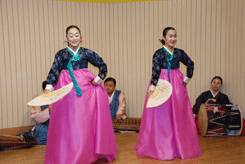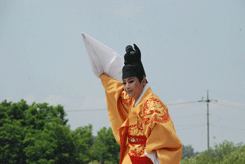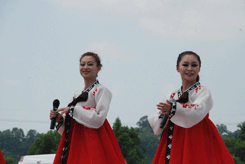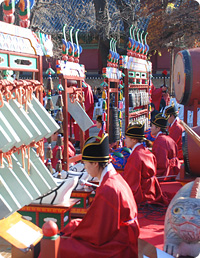Music
 |
 |
 |
Korean traditional music
Korea is rich in terms of musical culture, and its music is distinctive despite tremendous influences from China. Korean traditional music can be roughly divided into two major categories, Jeong-ak and Sog-ak, music for the ruling class and for the common people, respectively. Within these two major types are various subcategories that make up the whole of Korean music. In Jeong-ak there are two different, but somewhat related meanings. In its broader sense, the term refers to the elegant musical style that was considered "right" for the Korean ruling class in terms of Confucian philosophy, and within this broader meaning it also refers to ensemble music for men of high social status outside of the court. In this context, the important terms are A-ak, Dang-ak, Hyang-ak, and Confucian ritual music. A-ak is ritual temple music, of which at the present time only one example of Munmyo-ak remains. Munmyo-ak is performed at the shrine where Confucius and his disciples are honored. Dang-ak refers to secular music of both the Chinese Tang and Sung dynasties, which was altered to become a court music after its introduction to Korea. Hyang-ak simple means native Korean music, a noted example of which is Sujecheon, a piece of instrumental music often claimed to be at least 1,300 years old. That would predate the first compilation of Gregorian chants. Court music, a subcategory of Jeong-ak, includes three types: ritual, banquet and military music. Ritual music includes Confucian, royal shrine and court banquet. Sujecheon is one of the most famous pieces of banquet music. Music for upper class consists of a type of ensemble music.
Royal court music
Joseon court music had been composed and refined according to the Confucian concept, which pursued the harmonization of the human heart with the natural order and thus encouraged social virtue. The court music was consistently demanded for state events such as state rites, banquets, ceremonies or royal processions. Even within a single event, the music changed according to the scale, purpose and significance of each procedure. The sounds played by the orchestra were produced by instruments made of natural materials such as clay, leather, wood, stone, silk or metal, thus realizing the harmony of men and nature.
Pungnyu
Pungnyu is the most sophisticated Korean lyric song genre, Gagok and the indigenous Korean popular song sijo. Pungnyu is an archaic word that formerly meant music in general. Its present literal meaning denotes the stage of being in which a man at leisure removes himself from everyday world into a harmonious mood right for the appreciation of poetry, music, and female companionship. When the term is used in the context of Korean classical music, however, it refers to a type of ensemble music
for the nobility. One variety of this music, called Hulpungnyu, consists mainly of stringed instruments. Joseon aristocrats placed great value on enjoying a peaceful break in nature away from their everyday routines. Amid the beauty of nature, they enjoyed drinking and listening to music played on the popular zither, Geomungo, or Pansori narrative folk songs. They also composed poems that rhymed after one another or looked at paintings. These were all regarded as important activities for cultivating the elegant artistic tastes (Pungnyu) suited to the educated elite. They also enjoyed playing Baduk or chess. Some trained body and mind through archery or games of throwing arrows into a jar.
A second variety, Taepungnyu, consists mainly of wind instruments, and a third is a combination of the first tow. Gagok used a rhythmic pattern of either a 16-beat Jangdan (which literally means Long-short) or its varied form, a 10-beat Jangdan. Any Gagok selection is based on the Ujo or Gyemyonjo mode, or sometimes on both. Instruments used for accompaniment are the Geomungo, Gayageum, Yanggeum, Haegeum, Piri and Janggo. Sok-ak, music for the commoner includes shaman music, Buddhist music, folk songs, farmers' music called Nong-ak, Pansori (a form of dramatic song), and an instrumental solo music called Sanjo. In shaman music, the role of an inspired female shaman priest called a Mudang is very important. The Mudang plays the part of medium between the visible world and the supernatural. Singing, dancing and instrument playing are always involved. One of the most important types of Buddhist music is Beompae, a song of praise to Buddha, and today Beompae is preserved by only a few priests. Since Korea traditionally has been an agricultural nation, the life of the farmer has always had significant influence on the musical history of the country. The most interesting characteristic of farmers' music is its 12 different rhythmic patterns called Sippichae, which are led by a small gong. One of the more appealing types of Sog-ak is the Sanjo, an instrumental solo piece originally in improvisational style for various instruments: Gayageum, Geomungo, Daegeum, Haegeum, Danso and Piri. Pansori is another musical treasure that is an indigenous opera-like production. Within the Pansori, Aniri is the spoken description of the dramatic content between songs, and Ballim is the physical motion of the drama






